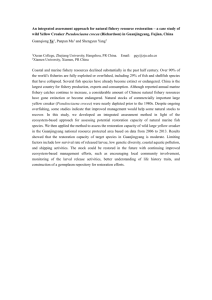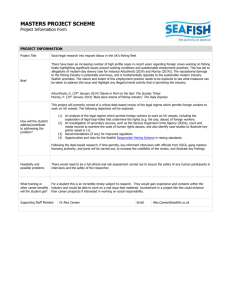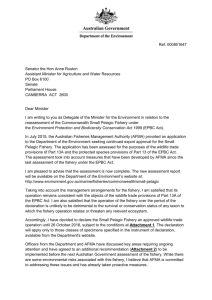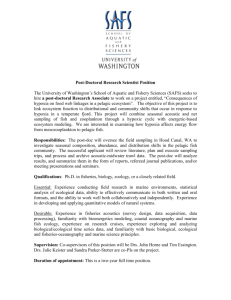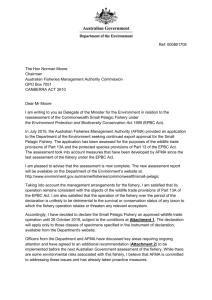Fishery_Document_(2)
advertisement
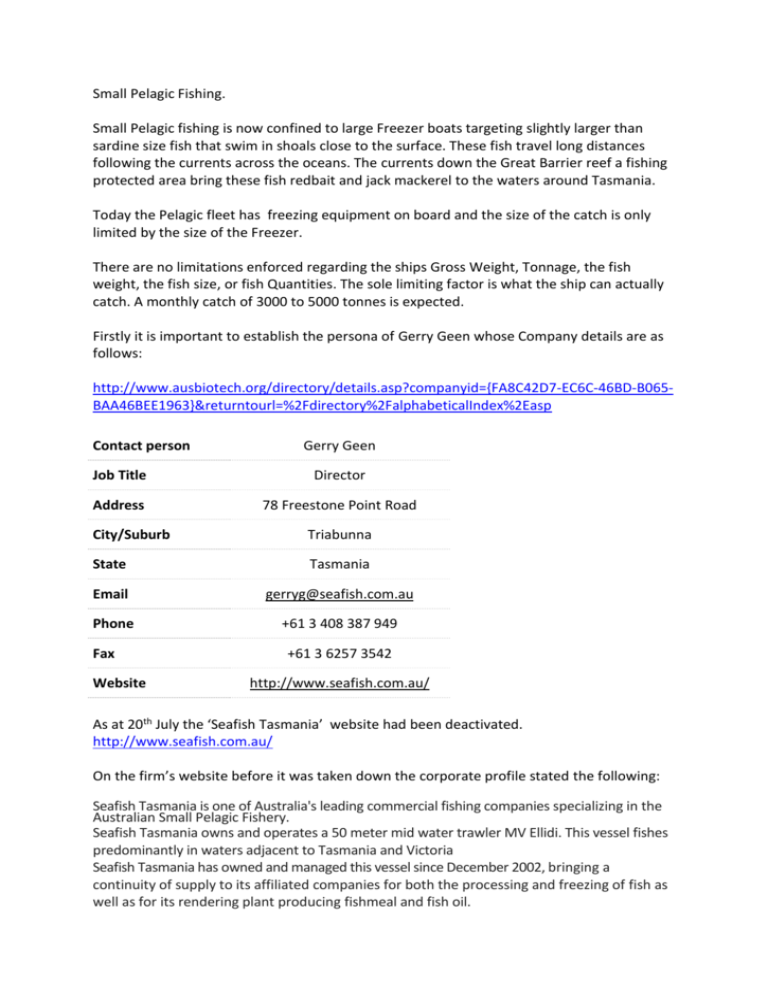
Small Pelagic Fishing.
Small Pelagic fishing is now confined to large Freezer boats targeting slightly larger than
sardine size fish that swim in shoals close to the surface. These fish travel long distances
following the currents across the oceans. The currents down the Great Barrier reef a fishing
protected area bring these fish redbait and jack mackerel to the waters around Tasmania.
Today the Pelagic fleet has freezing equipment on board and the size of the catch is only
limited by the size of the Freezer.
There are no limitations enforced regarding the ships Gross Weight, Tonnage, the fish
weight, the fish size, or fish Quantities. The sole limiting factor is what the ship can actually
catch. A monthly catch of 3000 to 5000 tonnes is expected.
Firstly it is important to establish the persona of Gerry Geen whose Company details are as
follows:
http://www.ausbiotech.org/directory/details.asp?companyid={FA8C42D7-EC6C-46BD-B065BAA46BEE1963}&returntourl=%2Fdirectory%2FalphabeticalIndex%2Easp
Contact person
Gerry Geen
Job Title
Director
Address
78 Freestone Point Road
City/Suburb
Triabunna
State
Tasmania
Email
gerryg@seafish.com.au
Phone
+61 3 408 387 949
Fax
Website
+61 3 6257 3542
http://www.seafish.com.au/
As at 20th July the ‘Seafish Tasmania’ website had been deactivated.
http://www.seafish.com.au/
On the firm’s website before it was taken down the corporate profile stated the following:
Seafish Tasmania is one of Australia's leading commercial fishing companies specializing in the
Australian Small Pelagic Fishery.
Seafish Tasmania owns and operates a 50 meter mid water trawler MV Ellidi. This vessel fishes
predominantly in waters adjacent to Tasmania and Victoria
Seafish Tasmania has owned and managed this vessel since December 2002, bringing a
continuity of supply to its affiliated companies for both the processing and freezing of fish as
well as for its rendering plant producing fishmeal and fish oil.
Under pressure as a resultof the proposed visit of the giant freezer trawler Magiris , Geen
gave the following interview to the Hobart Mercury. In the interview he confirmed it was his
quota’s the ship was taking up and it should be noted their location around Tasmania
Mercury July 15 2012
http://www.themercury.com.au/article/2012/07/15/346571_tasmania-news.html
‘The Seafish Pelagic joint venture comprises the Margiris super trawler, owned by two
Dutchmen, and the quota owned by Seafish Tasmania.
While the debate had been frustrating, Mr Geen said the super trawler was necessary to
make fishing of jack mackerel and redbait profitable.
"In 2002 we invested $3.5 million to buy a purpose-built vessel from Iceland [MV Ellidi ] but
we learnt that it wasn't appropriate because you have to have a much wider range," he said.
"You have to capture economies of scale because these fish are not worth much. You have
to catch them, freeze them, cold store them and freight them to the market for less than a
dollar a kilogram."
The Margiris will catch its quota in Commonwealth waters, more than three miles from the
coast of states in an area stretching from Queensland to Western Australia.
The fish will be sent to West Africa for human consumption.
"There have been three studies by CSIRO on the effects of fishing mackerel and redbait
which found that the levels of fishing set by AFMA would have absolutely no noticeable
effect on the eco-system," he said.’
This latter paragraph makes no mention of his Committee membership of the Small Pelagic
Fishery Resource Management Advisory Committee on which he has sat since its inception
in 2005 of which more later.
Gerry Geen appears with a totally different modus operandi in an article in Landmark , The
official magazine of Victoria’s land information industry Issue 18 June 2004
http://www.xyz.au.com/public/assoc_service_members/pdf_files/Landmark%20June%2020
04lo.pdf
I quote verbatim:
‘It’s every commercial fisherman’s dream ... the mother of all fish finders! No more spending
endless and expensive hours searching the ocean for the right spot to cast your net – just
switch on your shipboard computer, use your satellite phone to download some satellitebased maps showing concentrations of plankton, water temperature, ocean currents and
other data ... and you can see the spots where those elusive fish are most likely to be.
Perhaps you think it all sounds a little ... fishy!
Not so says Gerry Geen, a partner in a company, Seafish Tasmania Pty Ltd,that fishes a
20,000 square kilometre area of water off the southeast coast of Victoria stretching from
Flinders Island south along the eastern and western coasts of Tasmania. Gerry’s crews are
hunting two particular species – Mackerel and Redbait. Both types often occupy the open
waters between the coast and the edge of the continental shelf in depths from 20-300
metres. That’s where Gerry Geen is focusing his efforts and, since last January, his trawler
captains have been getting plenty of help from a novel fish-finder system called the SeaStar
Fisheries Information Service (SFIS). The commercial service is provided by a US based
company, ORBIMAGE Inc, which operates two earth-orbiting satellites to provide its
customers throughout the world with a range of Earth imagery products and services. The
satellites are backed up by a worldwide integrated image receiving, processing and
distribution network. One of the satellites, OrbView-3, which was launched last year,
provides one-metre resolution panchromatic (black and white).
Above: Seafish Tasmania’s lead trawler, the Ellidi, is finding better fishing grounds with the
help of location-based data provided by satellite.
Above: A false-color “plankton” image shows the concentration of chlorophyll-a, the green
pigment in plankton. The colors range from high chlorophyll-a (dark green) to low
chlorophyll-a (dark blue). The black lines are surface temperature contour lines at 0.5
degree Celsius intervals.
The main location of the fish is East and West of Tasmania
How does it work? “It’s relatively simple and very user friendly,” says Geen.“We use the onboard satellite phone to download satellite imagery showing the amount of plankton in the
water, surface and sub-surface temperatures, wave height and current information and a lot
of other data, including the weather. “Our Orb Map on-board computer software program
overlays this data on local area maps and, coupled with local knowledge, we have a very
useful decision-making tool to help us decide the best places to fish. metres of the fish –
anything further away than 500 metres and we are virtually blind. “This technology gives us
the additional information we need about likely locations. “On one occasion recently, our
trawler captain noted an area of high plankton density and colder water temperatures off
the east coast of Flinders Island. I sent the boat up there – as soon as we got there, the fish
were there. It was very striking evidence and gave us a lot of confidence in the system. “One
of the main characteristics of pelagic fish is that they are mobile or migratory. Most are
strongly influenced by water.
Geen was a founder Committee member of what is now the Small Pelagic Fishery Resource
Assessment Group (SPFRAG) which started life as (SPFMAC) or Small Pelagic Fishery
Resource Management Advisory Committee.
The first meeting of this Management Advisory Committee took place in Canberra between
the 27th and 28th April 2005, there have subsequently been annual meetings until 2010
when (SPFMAC) was dissolved and became SPFRAG.
I ask why was it dissolved?
The SPFMAC archive incorporating SPFRAG is available on the web as a complete archive at
http://www.afma.gov.au/managing-our-fisheries/consultation/management-advisorycommittees/south-east-mac/archive/spfmac/
Mr Gerry Geen along with Dennis Brown, Terry Romaro and Michael Thomas, all permit
holders to fish, declared their pecuniary interest in the fishery. Mr Gerry Geen controlled
the following permits:
SPF Permit Holder (two Zone A, B, C, D midwater trawl and purse-seine Permit packages;
four Zone A purse-siene Permits), Tasmanian purse-seine Jack Mackerel Permit holder (four
Permits) and a holder of a Southern and Eastern Scalefish and Sharkfish Trawl Boat SFR.
Much like Forestry in Tasmania the Permit holders were from the outset at the table as the
rules were being made. At the first meeting Agenda item 2 was up for discussion and I
quote:
http://www.afma.gov.au/wp-content/uploads/2010/07/SPFMAC-1-record.pdf
‘2. Strategic overview of the fishery
SPFMAC discussed the issues having greatest impact on the management of the fishery.
The MAC agreed that the fishery was characterised by:
a) opportunity for development;
b) fish species that are highly mobile and particularly responsive to changes in
oceanographic conditions;
c) relatively high levels of uncertainty in stock abundance and dynamics;
d) relatively high levels of uncertainty in the role of small pelagic species in the broader
marine ecosystem;
e) capital intensive catching and processing sectors;
f) high volume and low value product; and
g) different jurisdictional arrangements applying to the target species across their range.
In this context the MAC agreed that:
• a precautionary and measured approach to development of the fishery was necessary;
• there was a need to address the ecological/biological uncertainty through research and
that fishery independent data provided the most reliable information for management;
• valuable research projects were currently underway;
• in the face of limited research funds, there would be a need for an industry contribution to
research;
• maximisation of economic efficiency would be critical to the success of the fishery and
that in this respect secure fishing rights and reduced impediments to operational
efficiency were important in facilitating rational development; and
• there was a need to minimise the impact of OCS arrangements on management of the
target and non-target species and ensure complementary management arrangements
are in place across the jurisdictions.
The Tasmanian Mr Grant Pullen in his absence requested item 2 be omitted from the draft
agenda, in his absence no change was made. This becomes important later.
5.1 Conditions, process and timeframe for ending the boat nomination freeze
The Board requested SPFMAC provide early advice on possible conditions, process and
timeframe for ending the boat nomination freeze. The Board noted in its advice the
potential impact of the boat nomination freeze on existing permit holders.
The MAC noted that the management policy for the fishery had reflected the need for
gradual expansion of catch and effort in order to ensure that any significant impacts on
target species, by-catch species, including cetaceans, or the ecosystem in which the fishery
operates were able to be detected and addressed where necessary. This approach had been
taken in recognition of the uncertainty in relation to the levels of fishing effort that the
target stocks and the ecosystem could sustain.
The MAC confirmed its view that this cautious and measured approach to development
remained appropriate, particularly until the management plan was implemented, probably
in mid-2006. The MAC considered that until that time lifting of the freeze would provide a
window of opportunity for new vessels to enter the fishery and potentially result in rapid
increases in catch, up to the level of the TCL. The MAC also noted the concern by State
management agencies over the potential increase of by-catch of State managed species by
large freezer vessels. In forming this view the MAC noted that the current investment
warning reduced, but did not completely remove, the potential for this to occur. The MAC
stressed that it was the potential for the rate at which catch and effort could increase that
was of concern, rather than the TCLs being reached. The MAC agreed that the trigger catch
limits (TCLs) were precautionary.
The MAC therefore saw value in retaining the freeze until the Management Plan is
implemented. However, the MAC noted that there had been a growing interest in the
fishery prior to the imposition of the freeze and that a number of boats which had a history
of participation in the fishery but which had not been nominated against permits for various
reasons were now precluded from re-entering the fishery. This was acting as a brake on
what had been accepted as a gradual rate of expansion of the fishery.
The MAC noted that the Board's rationale for implementation of the freeze had been to
preclude the possible entry of large fishing vessels into the fishery [that] could lead to rapid
overcapitalisation in the fishery" (Media Release 26/11/2004).
The MAC agreed that what characterised a 'large' vessel in a fishery such as the SPF was the
level of on board freezing capacity, since it was this capacity that would be the major
determinant of increased catch. The MAC noted that current permit conditions prevented
transhipment. The MAC agreed that a 'large' vessel could be defined as one having a daily
onboard freezing capacity (plate or air blast) of 50 tonnes or more.
The MAC considered that the retention of the freeze in any form did compromise
maximisation of economic efficiency in the short term. However the MAC agreed that the
long-term benefits to economic efficiency of minimising the risk of overcapitalisation in the
fishery prior to implementation of the Management Plan were likely to outweigh the short
term costs. From an ESD perspective the MAC believed that excluding large vessels with
freezing capacity of greater than 50 tonnes per day, combined with monitoring of the rate
of increase in catch by the remainder of the fleet, until implementation of the Plan, was also
consistent with AFMA's ESD objective.
TAC stands for Total Allowable Catch
Update on State Arrangements for SPFMAC
The States manage small pelagic resources as status quo species within 3 nautical
miles of the coastline in each State, in Zones B, C and D of the SPF. However, at
present the Commonwealth manage SPF resources within 3nm west of 125°E in
Zone B off WA.’
South Australia, NSW and WA provided 3 pages of text under attachment 1 describing the
methods and history of their fishing, it should be noted that the states off which the
majority of the fish are located supplied minimum documentation, Tasmania 3 lines,
Victoria, nothing.
WHY?
Meeting 4.
http://www.afma.gov.au/wp-content/uploads/2010/07/SPFMAC-4-meeting_record.pdf
‘Known stock structures
Dr James Findlay (Scientific Member) advised the Committee that determining stock
structures is an inherently complex undertaking that is rarely devoid of uncertainty. Dr
Findlay explained that there are several methods (~28) that may be used to determine stock
structures, many of which are costly. In the context of the SPF Dr Findlay reported that
there is sufficient scientific understanding of the factors (Leeuwin and East Australian
currents) affecting the structure of pelagic species in Australian waters to warrant
assessment of the fishery as having east and west stocks. Dr Findlay explained that the
meridian of longitude 141° East would be an appropriate delineation of east and west zones
in the SPF as it is an established boundary for other Commonwealth fisheries targeting
pelagic species. Dr Findlay noted that the boundary also represents the western limit of
Western and Central Pacific Fisheries Commission. Dr Findlay also noted that there was
some information to suggest that separate stocks may exist in the far west but that this was
far more speculative. According to Dr Findlay most uncertainty surrounds the structure of
redbait. Drawing on industry experience, the potential influence of the Zeehan Current and
preliminary results from the FRDC funded redbait project it was suggested by industry that
separate redbait stocks may exist east and west of Tasmania. Industry reported that
different size ranges and spawning times have been observed.
Mr Geen gave a presentation to the MAC on these theories (Attachment B). On the basis of
industry’s advice Dr Findlay agreed that that the meridian of longitude 147° East would also
be a suitable division of the fishery south of Tasmania. To achieve further cost-effectiveness
and efficiencies members agreed that if option 5 was to be adopted, that the boundary
separating Zones C and D (meridian of longitude 146° 30′East) would provide the most
administratively simple separation of the east and west zone north of Tasmania. Mr Geen
advised that based on consultations with the broader industry, Zone A holders would
support a 50% apportionment of Zone A SFRs to the proposed east and west zones
respectively.
Equity of access
The major unresolved issue was the potential impact of option 5 on the relative value of
Statutory Fishing Rights (SFRs). Some Members argued that it was inequitable to
amalgamate Zones B, C and D with Zone A on the basis that the zones are underdeveloped
and will have access to a significantly smaller share of the total number of available SFR
units and quota (based on current TCLs) under the Plan. Members believed that operators in
Zones B, C and D should have the opportunity to develop the fishery within each zone
independent of competition from Zone A concession holders.
Members in support of option 5 believed that the distribution of SFRs within the fishery was
an irrelevant consideration for the MAC. It was noted that the fishery’s allocation
framework serves to establish access rights relative to the economic standing of holders
established in the fishery and should not be an impediment to the adoption of management
measures that best pursue AFMA’s legislative objectives. These Members disputed the main
premise of support for option 2 noting that, in line with stock based management, it is
unlikely that TACs for the same stock would vary independently within zones (i.e. allowing
independent development).
There was no support within the MAC for revisiting the agreed basis for allocation of SFRs in
the fishery.’
I suggest that the power of vested interest is here displayed.
Leuuwin/Zeehan Current
Winter
Summer
Meeting Number 11 in 2011
http://www.afma.gov.au/wp-content/uploads/2010/06/SPFRAG-11-meeting-recordFinal_8.12.11_.pdf
Effort in the east was concentrated in NSW and Tasmania, while in the west there has been
little effort. Catches of Jack Mackerel in the east have been variable, declining from more
than 9,000 tonnes in 1997-98 to approximately 100 tonnes in 2000-01; increasing to more
than 2,000 tonnes between 2002-03 and 2003-04, and declining again to less than 2 000
tonnes since 2005-06. Catches in the west are lower than the east, having only exceeded
330 tonnes on two occasions, in 2005-06 and 2006-07.
This I suggest is proof positive of the amount of fish caught even allowing for satellite
technology by small vessels.
Biological data were presented, including length, GSI data and age structure. Tim Ward
noted that recently smaller fish were making up a greater proportion of catch in the Jack
Mackerel fishery.
There has been no DEPM survey for Jack Mackerel east or west so management strategy
evaluation results needed to be treated with caution. However, catches have been lower
than historic levels and there was no evidence to suggest that current low catch levels are
not sustainable.
In the past year there had been 1000 tonnes of Jack Mackerel caught in the east and 100
tonnes in the west. The reservations of the Recreational/Charter Fishing Member and
Environmental Member in relation to Jack Mackerel harvest levels from the SPFRAG
meeting held on 21 April 2010 were noted.
The Recreational/Charter Fishing Member maintained the same reservations this year,
however, noted that the current low level of catch provided some comfort while awaiting
fishery independent data for the fishery. The Recreational/Charter Fishing Member’s view
was that data independent of the fishery were still required for assessment purposes.
It was noted that TAFI’s report on Jack Mackerel using historic fishery independent data
should be available in the next few months.
RECOMMENDATIONS: The SPFRAG recommended the following RBCs apply for 2011-12:
Jack Mackerel east RBC 5 000 tonnes
Jack Mackerel west: RBC 5 000 tonnes
The Recreational/Charter Fishing Member noted his ongoing reservation that no DEPM
survey had been completed for the stock and that fishery independent data was required to
provide requisite certainty to justify catch levels.
To summarise the above in 2011 catches were small but the allowable limits are high the
licence holders will benefit if a giant trawler becomes available to power up to the limits and
Geen will make money.
Redbait (east and west)
Before 2001-02, catches of Redbait in the east were negligible at less than 200 tonnes.
Catches increased to 3,800 tonnes in 2001-02 and peaked at approximately 7,000 tonnes in
2003-04. Catches have declined since then to approximately 300 tonnes in 2009-10. Catches
of Redbait in the west were lower than the east. Catches in the west also displayed a clear
peak of greater than 3,000 tonnes in 2005-06 (a few years later than the peak in the east).It
was noted that it would be useful to include descriptive information about fishing effort
levels. Tim Ward advised that he would aim to include a rolling history for each fishery in
the 2012 Fishery Assessment Report. This year’s report would include a precautionary note
about the use of data.
CPUE, size, length frequency and age distribution data were considered by the SPFRAG. The
difference in distribution between east and west and purse seine and mid water trawl was
discussed. An apparent large difference between size and age at maturity between east and
west stocks was noted and discussed.
The DEPM estimate for Redbait in the east suggests a spawning biomass in excess of 50 000
tonnes. It was noted that because of apparent changes in distribution of redbait, a DEPM
survey carried out now may produce different results.
Fishing in the west has been limited to a small area of South West Tasmania, indicating that
stock is subjected to limited fishing pressure. There is no evidence to suggest catches of
Redbait in either the eastern or western zones are not sustainable.
The Chair noted that Redbait east was under Tier 1 of the Harvest Strategy, the survey being
4 years old representing a decay factor of 12.5% and maximum RBC of 8 600 tonnes.
Redbait west is under Tier 2 of the Harvest Strategy with a default limit of 5 000 tonnes.
Most recent catches have been low with approximately 350 tonnes in the east and 100
tonnes in the west.
The Recreational/Charter Fishing Member expressed concern about some uncertainties and
unexplained fluctuations in the data. He noted that current low catch levels provided some
comfort but his view was that fishery independent data were required for certainty of the
stock assessments for Redbait.
Industry Member, Gerry Geen, noted that effort in the fishery had reduced significantly with
only one active operator, however, he had received reports from operators in other
fisheries of catches of Redbait, such as catches by bottom trawlers at depths of 300 – 400
metres.
Jeremy Lyle advised that he had received reports from recreational fishing operators of an
abundance of Redbait in large schools.
RECOMMENDATION: The SPFRAG recommended the following RBCs apply for 2011-12:
Redbait east: RBC 8 600 tonnes (Tier 1 under the Harvest Strategy)
Redbait west: RBC 5 000 tonnes (Tier 2 under the Harvest Strategy)
The Recreational/Charter Fishing Member noted his reservation that fishery independent
data were required for certainty of stock assessments for Redbait and that, given some
variations in data, a DEPM survey should be undertaken to provide greater certainty of
harvest level.
Grant Pullen is now the Tasmanian State Government representative on the SPFRAG board,
what does tell you? And why did the State Government gift Seafish Tasmania 150,000
dollars.
The total allowable catch of Jack Mackerel and Redbait is now 23,600 tonnes and I suggest
that this is what is now available to be caught.Seafish Tasmania has an allocation of
approximately 18,000 tonnes.
AFMA Disclosure Log
http://www.afma.gov.au/resource-centre/publications-and-forms/corporate/freedom-ofinformation/afma-disclosure-log/
Jack Mackerel
http://www.afma.gov.au/information-used-to-set-the-total-allowable-catch-for-jackmackerel-for-2012-13/?preview=true&preview_id=19368&preview_nonce=df8339ce7e
This link does not let you access the documents which were supposedly released on the 6 th
July 2012, stating that you do not have permission to view drafts.
WHY and is this the Report referred to above by Tim Ward in the 2012 Fishery Assessment
Report.
Scallops
The link for documents on scallops is readily available and accessible here:
http://www.afma.gov.au/resource-centre/publications-and-forms/corporate/freedom-ofinformation/afma-disclosure-log/disclosure-log-information-released-13-october-2011/
These scallop fisheries have been virtually destroyed.
Using the above sources, more can be made of this matter. I ask Mr Geen for a reply.


